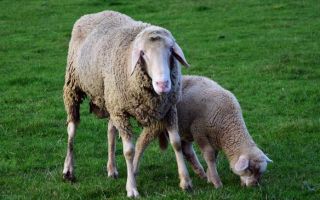Dicroceliosis is a disease caused by the lanceolate fluke.
Content
All about the lanceolate fluke
These worms belong to flatworms , trematodes, parasitize the liver of large and small livestock, and less commonly of humans.
The fluke in the marita stage has a length of 5-10 mm. The trematode has 2 compact round testes located closer to the anterior end of the body; behind them is an ovary. The uterus occupies the back of the body.
Life cycle
Marites parasitize the liver ducts of herbivores, rarely in humans. Eggs with feces fall into the soil and are swallowed by terrestrial mollusks, in the liver of which the miracidium forms a first-order sporocyst. Second-order sporocysts are formed inside it. In which cercariae develop. The latter penetrate the lung of the mollusk and, encysting, turn into prefabricated cysts, which are secreted out with mucus and eaten by the second intermediate host - ants.
In the ant's body, one of the circaria actively moves and is located next to the cerebral ganglion. As a result, the ant's behavior changes. Infected ants work throughout the day along with everyone else. But in the evening, when the air temperature drops, they climb to the tops of the stems and leaves of herbaceous plants, cling to them with their jaws and hang until the morning, losing the ability to move.
As a result of this behavior, the likelihood that infected ants will be eaten by livestock increases and the parasite will enter the body of the final host.
The lifespan of the parasite in the host body is 6 years.
Dicroceliosis
The disease caused by the lanceolate fluke is called dicroceliosis, it is characterized by damage to the hepatobiliary system.
This helminthiasis is recorded in Europe, Asia, Africa, North and South America. In Russia, it is widespread; the most intense infestations are noted in the southern regions of our country, where small livestock (sheep, goats) are universally affected by the helminth.
How can you get infected?
The source of infection is the definitive hosts of the helminth - sheep, goats, cattle, bears, wild ungulates, some rodents and lagomorphs.
A person becomes infected by accidentally ingesting infected ants with vegetables, berries, or wild edible herbaceous plants. Children get sick more often.
The disease develops in the same way as fascioliasis , but the pathological processes and clinical symptoms are much less pronounced.
With severe infection, the outflow of bile is disrupted, which leads to the development
- catarrhal cholangitis,
- angiocholitis,
- biliary dyskinesia,
- sometimes hepatitis.
Symptoms
With low intensity of infection, the disease occurs with minor manifestations or asymptomatically.
With severe infection, the acute phase of the disease is pronounced. There are:
- nausea,
- vomit,
- salivation,
- heartburn,
- bitterness in the mouth,
- headache,
- temperature increase,
- pain in the right half of the abdomen and epigastrium.
The liver is enlarged, its surface is smooth, the edges are rounded, and sometimes the spleen is enlarged. Allergic syndrome (urticaria) often appears, and loose stools appear.
The chronic stage develops 3-4 weeks after infection. It manifests itself with the following symptoms:
- paroxysmal pain in the right hypochondrium,
- loss of appetite,
- unstable chair.
With the addition of a bacterial infection and the development of ascending cholangitis, the temperature rises, the liver enlarges, leukocytosis develops, and the ESR increases. The disease can last 5 years.
Diagnostics
Differential diagnosis is carried out with other trematodes.
Diagnosis is based on the clinical picture of the disease, data on the patient’s contact with vegetation in pastoral areas and the results of laboratory tests.
In the laboratory, the duodenal contents and feces of the patient are examined, in which eggs are found.
After eating the liver of small and large ruminants affected by helminths, transit eggs are found in the feces. Therefore, a few days before the test, liver and its processed products should be excluded from the diet.
Treatment
The drug of choice is praziquantel . It is prescribed to children over 4 years of age and adults at a daily dose of 75 mg/kg body weight immediately after meals in 3 doses with an interval of 4-6 hours for 1 day.
The maximum single dose is 2 grams, the maximum daily dose is 6 grams (10 tablets).
For the treatment of adults, triclabendazole can also be used, as for fascioliasis.
In the late stage of the disease, with cholangitis and dyskinesia of the gallbladder, duodenal intubation is performed with the introduction of magnesium sulfate or sorbitol 1-2 times a week for 1-2 months. Choleretic drugs are indicated, preferably from the group of cholekinetics.
For pain, antispasmodics and analgesics are used. When a secondary infection occurs, antibiotics are prescribed taking into account the sensitivity of the microflora of the duodenal contents to them.
For anemia, especially in children, patients are prescribed a complete protein-vitamin diet and iron supplements.
Monitoring the effectiveness of treatment is carried out in the same way as with fascioliasis.
Prognosis and prevention
The prognosis for treatment is favorable.
To prevent infection, veterinary services must carry out
- sanitization of infected animals,
- sanitary and educational work with the population, especially among people professionally associated with livestock farming,
- eliminating the possibility of ants being swallowed or getting into food.
To prevent dicroceliosis it is necessary
- wash your hands thoroughly,
- treat meadow vegetation (sorrel, etc.) with boiling water before eating,
- On hiking trips, it is recommended to pack food in plastic bags.







